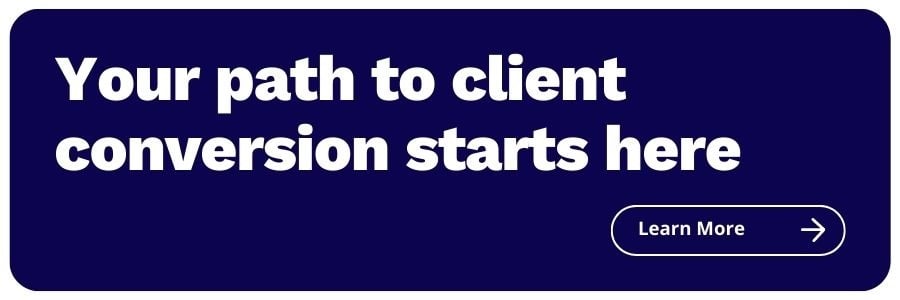5 Places to Look for and Find Your First Clients
Share this
Starting your own practice comes with a lot of decisions. What CRM will you use? How will you tackle compliance issues? Who’s going to design your snazzy new website? Which company will serve as the best custodian?
These are all questions that need to be answered prior to launching in order to ensure you’re prepared to best serve your clients.
But wait -- what about your clients? How do you plan to actually find them and grow your business?
Kevin Costner’s famous declaration, “if you build it, they will come,” may have worked in Field of Dreams, but it doesn't exactly apply to a new financial planning practice. Unfortunately, clients won’t be knocking down your doors immediately upon launch.
To find your first clients, you’re going to have to take action, get out there, and spread the news about the incredible new business you’re building.
Curious as to how to actually start growing your client base? Read on for an overview of 5 places to look for and find those first few people that need your services.
Send a Launch E-mail
This is your opportunity to reach out to your circle (think your very extended circle) of friends, family, old co-workers, dentists, doctors, neighbors and anyone else in your e-mail address book to share with them how excited you are about your new venture.
Send them an e-mail updating them on the business, when you’re launching, why your launching, what sets you apart from the rest, and where they can find more information about what you’re doing. Provide links to your social media accounts, your website, and your newsletter signup spot.
A launch e-mail is a great tool to utilize in order to land your first client -- and a smart way to start growing your newsletter list right from the start.
Reach Out to Others in Your Industry
Chances are there are dozens, if not hundreds, of financial planners in existence in your hometown or area already. Think about what sets you apart from that cohort.
What type of clients are you serving versus the types of clients they are serving? How does the type of planning you do differ?
The fact of the matter is that there is a multitude of potential clients out there and only a finite number of financial planners. When you consider specific areas of expertise and what types of clients those planners specialize in, the number of people each professional can serve shrinks down further.
Chances are there are planners who serve a different market than you and would love to know who you are and what you do in order to refer those who they can't personally work with to someone they know can help (you!). Getting in front of advisors and sharing what you do makes it easy for them to refer you clients that fit the description of who you want to work with.
Reach out and ask for coffee meetings or phone calls with other advisors in order to learn more about their business, share your story, and develop a positive working relationship with professionals in the industry.
Look for Your First Clients in Your Niche Market
Defining a niche is one of the most important things to do when launching a financial planning practice.
What type of client will you specialize in working with? It's not enough to stop at "Gen X and Gen Y," or "women." You must dig deeper if you want to truly make an impact in the market and build a name for yourself.
Think about the unique things you have experienced and the hobbies you enjoy. Those who are part of these groups will be your natural market as you’ll likely already have trusted relationships or things in common.
Whether you’re former military, a proud yogi or cross fitter, a soccer fanatic, or someone who adopted a child, you do have a niche that you can service. You just need to understand how to find that niche.
Having something in common with your niche market can help form stronger bonds and connections, too. Consider these practical examples of how fitting into a niche via your unique experiences and connections makes a difference:
- Working with those who adopt in order to navigate the financial decisions associated with that particular situation (like issues of funding).
- Working with members of the military to help them understand their changing finances as they transition to civilian life.
In addition, having a defined niche makes it much easier to streamline your practice.
Use Social Media
Social media is one of those things that you just have to get active on. Not sure where to start? Twitter is a great way to connect with other industry professionals and makes it easy to find potential collaborators.
By sharing your voice and opinion and engaging in conversation with others in the industry, you can build awareness around what type of business you’re building and the target clients you work with. This is helpful not only for referrals, but also in terms of getting press for yourself.
Many reporters for industry, national and local publications are active on Twitter. This grants you instant access and an opportunity to connect and engage. (Side note: engage, don’t pitch yourself.)
Lean on Family and Friends
Your family and friends are likely the people who love you the most and whom are the most excited about your new business (aside from you). Ensure that they understand exactly what your practice embodies.
Here's what your friends and family need to know about your new business:
- Who are you working with? Who is your ideal client?
- What types of services do you provide?
- How do you charge clients?
- How do you bring clarity and organization to your client’s lives?
- What does a good referral look like?
When you launch, you’re likely going to have friends and family talking about what you’re doing with people they know. They’re going to want to help you by sending anyone they can your way.
You may have a 65-year-old client who was referred from your grandma and a 30-year-old newlywed couple from your best friend. Make sure you educate your close circle on what you’re looking to accomplish so they can help you get there by sending the right people your way.
Ultimately, it takes time and patience to build a book of clients and it’s up to you to stay the course. Don’t be afraid to look outside the box when it comes to growing.
While traditional networking groups are a great way to connect with others, it’s also fun to dig down into your hobbies and interests and see the kind of impact you can make within those groups.

About the Author
Mary Beth Storjohann is the founder of Workable Wealth, and on a mission to empower her generation to get on the right financial track by helping them to make smart, educated decisions with their money.
Share this
- Road to Launch with XYPN Member Alan Skillern, CFP®, MBA
- Coaching for Better Time Management: Prioritizing Organic Growth in Your Daily Routine
- Boost Your Financial Advisory Practice: SEO Strategies and CRM Optimization for Sales Success
- Navigating the AI Revolution: What Financial Advisors Need to Know
- Advisor Blog (692)
- Financial Advisors (221)
- Growing an RIA (99)
- Digital Marketing (87)
- Marketing (84)
- Community (81)
- Start an RIA (76)
- Coaching (72)
- Business Development (71)
- Running an RIA (70)
- Compliance (69)
- Client Acquisition (65)
- Technology (64)
- XYPN LIVE (59)
- Entrepreneurship (56)
- Sales (49)
- Practice Management (44)
- Client Engagement (41)
- XYPN Books (38)
- Bookkeeping (37)
- Investment Management (37)
- Fee-only advisor (36)
- Lifestyle, Family, & Personal Finance (31)
- Employee Engagement (30)
- Client Services (25)
- Financial Education & Resources (24)
- Journey Makers (21)
- Market Trends (21)
- Process (14)
- Niche (11)
- SEO (9)
- Scaling an RIA (9)
- Career Change (8)
- Transitioning Your Business (7)
- Partnership (6)
- Transitioning To Fee-Only (4)
- Social Media (3)
- Transitioning Clients (3)
- Emerald (2)
- Persona (2)
- RIA (2)
- Onboarding (1)
- Sapphire (1)
Subscribe by email
You May Also Like
These Related Stories

How Financial Advisors Can Master Referrals: What Would Arlene Say?
Jan 17, 2019
13 min read

Choosing a Niche for Your Financial Planning Firm
April 10, 2017
7 min read





